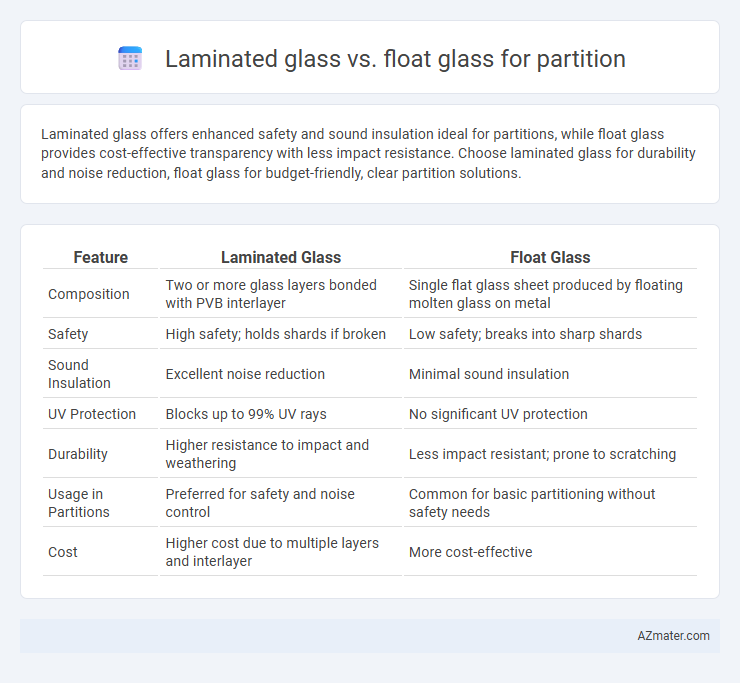Laminated glass offers enhanced safety and sound insulation ideal for partitions, while float glass provides cost-effective transparency with less impact resistance. Choose laminated glass for durability and noise reduction, float glass for budget-friendly, clear partition solutions.
Table of Comparison
| Feature | Laminated Glass | Float Glass |
|---|---|---|
| Composition | Two or more glass layers bonded with PVB interlayer | Single flat glass sheet produced by floating molten glass on metal |
| Safety | High safety; holds shards if broken | Low safety; breaks into sharp shards |
| Sound Insulation | Excellent noise reduction | Minimal sound insulation |
| UV Protection | Blocks up to 99% UV rays | No significant UV protection |
| Durability | Higher resistance to impact and weathering | Less impact resistant; prone to scratching |
| Usage in Partitions | Preferred for safety and noise control | Common for basic partitioning without safety needs |
| Cost | Higher cost due to multiple layers and interlayer | More cost-effective |
Introduction to Glass Types for Partitions
Laminated glass consists of two or more layers of glass bonded with an interlayer, providing enhanced safety and sound insulation for partitions. Float glass is a single, flat sheet manufactured by floating molten glass on a bed of molten metal, offering clarity and cost-effectiveness but less impact resistance. Choosing between laminated and float glass impacts partition durability, safety, and acoustic performance in interior design.
What is Laminated Glass?
Laminated glass consists of two or more glass layers bonded with an interlayer, typically polyvinyl butyral (PVB), providing enhanced safety and sound insulation compared to float glass. It retains structural integrity upon impact, minimizing the risk of sharp shards, making it ideal for partitions in commercial and residential spaces. Unlike float glass, which is a single, flat glass sheet, laminated glass offers increased durability and security in interior partition applications.
What is Float Glass?
Float glass is a type of flat glass produced by floating molten glass on a bed of molten tin, resulting in a uniform thickness and smooth surface ideally suited for partitions. It offers high optical clarity and strength but lacks the safety features of laminated glass, which contains an interlayer to hold shards together upon impact. For partition applications, float glass provides a cost-effective, visually clear option, while laminated glass enhances safety and noise reduction.
Strength and Durability Comparison
Laminated glass offers superior strength and durability compared to float glass due to its multiple layers of glass bonded with an interlayer, providing enhanced impact resistance and reduced risk of shattering. Float glass, while more cost-effective and clear, is more prone to breakage and less effective in maintaining structural integrity under stress. For partitions requiring safety and long-term performance, laminated glass is the preferred choice.
Safety Features: Laminated vs Float Glass
Laminated glass offers superior safety features compared to float glass due to its inner layer of polyvinyl butyral (PVB), which holds the glass shards together upon impact, preventing dangerous splinters. Float glass, while structurally strong, shatters into large, sharp pieces that pose a significant safety risk in partition applications. For partitions requiring enhanced safety and impact resistance, laminated glass remains the preferred choice.
Acoustic Performance for Office Partitions
Laminated glass offers superior acoustic insulation for office partitions by incorporating a PVB interlayer that dampens sound vibrations, reducing noise transmission more effectively than float glass. Float glass, being a single pane without interlayers, provides minimal soundproofing and can allow higher levels of ambient noise between office spaces. For environments requiring enhanced privacy and noise control, laminated glass is the preferred choice due to its ability to significantly improve acoustic performance in partition installations.
Aesthetic Differences Between Laminated and Float Glass
Laminated glass offers enhanced aesthetic appeal with its ability to embed decorative films, patterns, or colors between glass layers, creating unique visual effects unmatched by float glass. Float glass, characterized by its smooth, clear, and uniform surface, provides a sleek and minimalist look but lacks customization options. The subtle distortion in laminated glass due to the interlayer can add depth and texture, making it a preferred choice for designers seeking both safety and artistic versatility in partitions.
Cost Considerations: Investment and Long-Term Value
Laminated glass generally entails a higher initial investment than float glass due to its complex manufacturing process involving multiple layers and interlayers for enhanced safety and sound insulation. Despite the upfront cost, laminated glass offers greater long-term value by reducing maintenance expenses and minimizing replacement frequency because of its durability and resistance to shattering. Float glass, while more affordable initially, may incur higher long-term costs related to repairs and lower energy efficiency in partition applications.
Environmental and Energy Efficiency Aspects
Laminated glass offers superior environmental benefits due to its ability to reduce UV radiation and enhance thermal insulation, leading to decreased energy consumption in climate control for partitions. Float glass, while more energy-intensive to produce, is highly recyclable and contributes to sustainability when incorporated into partition systems. The choice between laminated and float glass significantly impacts the overall energy efficiency and carbon footprint of interior partition designs.
Which Glass Type is Best for Your Partition?
Laminated glass offers superior safety and sound insulation for partitions, making it ideal for high-traffic or noise-sensitive environments. Float glass is more cost-effective and provides clear aesthetics but lacks the enhanced durability and noise reduction of laminated glass. Choosing between laminated and float glass depends on your priority for safety, acoustic performance, and budget in partition design.

Infographic: Laminated glass vs Float glass for Partition
 azmater.com
azmater.com